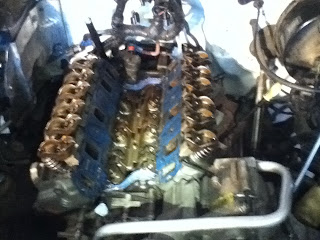This week has been chock full of crazy little things filling my grey matter. Finished up electrical week before last with a presentation by the automotive instructor. He had the Modis hooked up to the solenoid that controls the gas fume (?) cartridge. I got to see and understand more of what is happening when the spike occurs after the magnetic field collapses. From there it was a fairly easy correlation to draw as to what needs protecting in the computer modules, and how capacitors are used to capture electrical spikes like this to use somewhere else in a system instead of letting the energy go to waste.
Once finished with electrical I hit hydraulics pretty hard, finishing up my CAT basics, identifying about a third of the fittings, and getting through the walk-around on the simulator. My previous knowledge in hydraulics was all assumed and hearsay, so it's been really helpful to get the basic explanations out of the way. The kind of questions I don't think about asking. Learned how pistons work along with the different styles and the difference between pumps and motors and how to tell simply by looking at them from the outside. Was cool to finally figure out the axial pumps and see how they are made variable by using a pilot control pump to move the swash plate back and forth. I now also know that an axial pump is going to be used for higher pressure (>3000psi) even when it is fixed, as compared to a gear pump which will generally be used for lower pressure systems.

This is a gear pump I dis-assembled, made by Commercial Intertech. After taking it apart, I tried to figure out what the failure was. Inside the pump, on the walls on the inlet port side, something had caused either (1) cavitation, (2) aeration, (3) metal on metal contact, or possibly contamination. After watching how cavitation works I figured that the cavitation was going to occur more at the high pressure side. The fact that the grooves in the walls were constant all the way around ruled out both cavitation and aeration for me. I learned that if a gear pump is run at too high pressure, the film of oil that separates the gears from the walls will not be there as it has either been pushed through by force alone or the heat has caused the viscosity to drop too low to even create the film... or both. Also, turns out that the shafts that the idler and drive gears are on can actually flex under that much pressure, which can cause the gears to push out against the walls.

By feeling the bushings that sit in the pump case in which the gear and idler gears ride in, I found that the were in pretty rough shape. Also, as can be seen by the picture, there's been some pretty intense friction going on between bushing and shaft.
A close look at the gear teeth tells it all.
Identifying hydraulic fittings has been a true test of patience more than anything. Just when I thought that I had one figured out, the next one would stump me. I had to do a bunch of research on my own to figure this stuff out, if even a little bit.
My catch up was measuring fitting itself, which turns out to be kind of a big deal. Turns out close doesn't cut it when ordering parts, even though it's all Societies of the Nominally Vague. Basics for me was to know this:
-TAPERED
NPT/NPTF, BSPT, BSPP (<-- only one that isn't tapered)
-PARALLEL
UN/UNF, METRIC PARALLEL, METRIC TAPERED (<--- only one that isn't parallel, imagine that)
Once that's found out, using the handy dandy chart up there for step 1, I was then able to confidently measure the fittings correctly.
We messed around on the hydraulic board a bit late last week and, after struggling for a time, came to a pretty neat discovery regarding unidirectional restrictors and how they work. We were called in the instructions to set the pressure relief valve from 250psi - 500 psi in 50 psi increments and record the flow rate, time for the rod on one of the cylinder to extend, and time for the rod to retract.
Without spewing the data, we saw the extension time and the flow stay the same for every psi change but the retraction times decrease as the psi increased. We think what was happening was, as the schematic shows, that the check valve was only letting a certain amount of hydraulic fluid through the variable restriction, while during retraction the check valve would unseat, allowing the same amount of fluid through the variable restriction as well as through the check valve. At least, that's what we think happened. Have a lot to learn yet on it, but thinking about it all none-the-less.
Hours
Last 2 Weeks: 68
Total: 148































